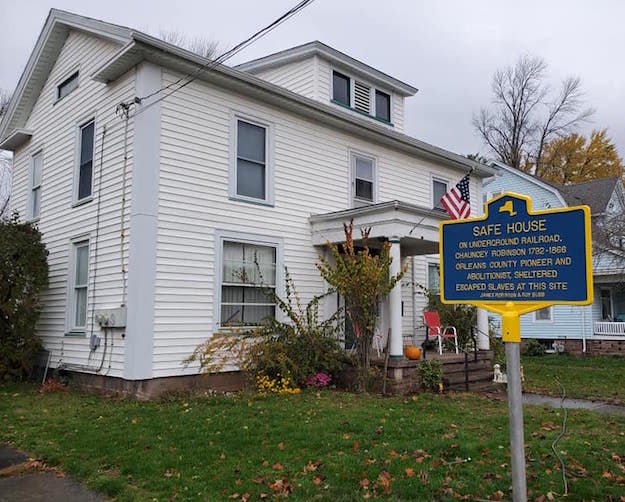Equipment and materials have risen dramatically, while state aid proposed to stay flat

Photos by Tom Rivers: Tracy Chalker, Clarendon highway superintendent and president of the Orleans County Highway Superintendents’ Association, speaks during a news conference on Friday afternoon at the Orleans County DPW garage.
ALBION – Local highway department leaders say a boost in CHIPS funding from the state would help the municipalities keep up with road and bridge maintenance.

A pothole has emerged on Butts Road in Albion near the railroad overpass. The highway departments in the county will be out when it warms up to fill some of the potholes. The harsh winter takes a toll on the local roads.
The costs for materials and equipment are up dramatically in the past three to four years. Gov. Kathy Hochul’s budget proposes keeping CHIPS at $598 million for the municipalities. Assemblyman Steve Hawley said the governor put an $800 million increase in the budget for the state Department of Transportation for its projects, citing the rising costs as the need for mor state funding.
Hawley said the vast majority of roads and bridges in the state are owned by towns, villages, cities and counties. They should see an increase in the state funding, too, Hawley said during a news conference in Albion at the Orleans County DPW garage. He would like to see a $250 million increase in CHIPS – Consolidated Local Street and Highway Improvement Program.
“Flat funding is a decrease,” Hawley said, noting the rising inflation.
Tracy Chalker, the Clarendon highway superintendent and president of the Orleans County Highway Superintendents Association, said an increase in CHIPS is needed to help the towns, villages and county keep the roads in safe condition for the traveling public.
“We cannot afford to stay flat or see a decrease in these programs,” Chalker said during the news conference.
Chalker said Orleans County municipalities are short-changed in part of the CHIPS formula that includes tourism. The county should be getting more state road funding for tourism because of the lakefront, canal towns, farm markets and other attractions, Chalker said.
About 25 highway leaders from Hawley’s district in Genesee, Orleans and western Monroe attended the conference.

Assemblyman Steve Hawley wants a $250 million increase from the state for CHIPS funding, from $598 million to $848 million. Hawley said the increase will help the municipalities keep up with rising costs for equipment and materials.
Chalker and many of the local superintendents will be in Albany next Wednesday for lobby day to press for more state aid. About 600 highway leaders are expected in the State Capitol.
“Do what is right for our infrastructure and keep it safe,” Chalker said.
Craig Lane, the Orleans County DPW commissioner, said the county paved 14 miles of roads last year. But with the rising costs for materials, “this year we’ll be lucky if we can do 10,” he said.
County Legislator Ed Morgan said the county budget is constrained by several state mandates that hinder the ability to spend on other local needs.
“So much of our county taxes go to the state mandates,” Morgan said.

Ed Morgan, a county legislator and retired Murray highway superintendent, said the state needs to “up and the ante” with road and bridge funding.
Well-maintained roads are critical for “trucks and tractors that are the lifeblood of our community,” said Morgan, who is retired from working 30 years as the Murray town highway superintendent.
“It’s imperative the state up and the ante and keep us competitive in Western New York,” Morgan said.
Local roads account for 87 percent of all roads in the state and carry 48 percent of all the vehicle miles traveled. However, they receive less than 12 percent of taxes and fees paid to the state for maintaining local roads, Hawley said.
A 2023 study of local highway and bridge needs commissioned by the New York State Association of Town Superintendents of Highways found that municipalities would need $32 billion over 15 years to restore locally owned roads through repaving and improvements or $2.1 billion annually. That study was updated this year and the amount is up about 25 percent – $2.69 billion a year or $40.35 billion over 15 years because of the spike in construction materials costs.

Craig Lane, Orleans County’s DPW commissioner, said costs are way up for projects and equipment. The county opened bids for two bridge projects and the low bids were about $250,000 more than engineers estimated when the projects were in the design phase about three to four years ago. The county also received a new 10-wheel dump truck on Thursday which cost $257,000, up from $168,000 in 2022.
Press Release, Congresswoman Claudia Tenney
WASHINGTON, DC – Congresswoman Claudia Tenney (NY-24) today introduced the State-Level Departments of Government Efficiency Establishment Act or the State-Level DOGE Establishment Act to crack down on waste, fraud, and abuse in state governments.
Specifically, this legislation conditions the disbursement of federal financial assistance, except for security-related funding, on states establishing an independent DOGE commission.
“DOGE is working diligently at the federal level to eliminate waste, fraud, and abuse. It’s time for state governments to follow suit,” Tenney said. “States like New York receive billions in federal aid annually, yet waste it on DEI initiatives and woke programs that are out of touch with the vast majority of Americans.
“It is imperative that these tax dollars are used properly and efficiently. The State-Level DOGE Establishment Act ensures that states create a DOGE commission to oversee the use of taxpayer funding and cut back on wasteful programs. If they refuse, they should not receive a dime of taxpayer money from the federal government.”
Return to top

ALBION – Some of the corrections officers on strike say the announced agreement to get COs back to work is “total bull s—.”
The COs say the agreement doesn’t change much in the working conditions that led to the strike at prisons in the state.
Officers are still subjected to about 800 hours of mandatory overtime a year, and the HALT Act, although temporarily suspended, hasn’t been rescinded. Corrections officers said the HALT Act and the mandatory overtime were the primary reasons for the strike, and those issues aren’t satisfactorily addressed in the agreement announced Thursday night by the governor and a mediator.

Corrections officers have this sign up along Gaines Basin Road, across from the Orleans Correctional Facility. About 75 corrections officers on strike were gathered at the location this morning.
“It seems pretty angry out here,” one striking CO said this more at an encampment across from the Orleans Correctional Facility.
The state wants the COs back on the job Saturday. If they show up for their shifts, they won’t face discipline.
But many of the workers at the site across from Orleans Correctional expect few will return to work on Saturday.
The officers also said too many drugs are making their way into the prison, putting staff at risk of exposure to dangerous drugs and substances.
There won’t be a vote among the union membership, which totals about 16,000 corrections officers and sergeants. They will show their support for the agreement by either going to work or remaining on strike.
One CO with 13 years of experience said he wants to get back to work, but the HALT Act needs to be revised to allow more punishment for inmates who break rules, cause fights, have shanks and other weapons, and have drugs or “hooch” that they make in the prison.
“We need to have some sanctions and disciplinary actions,” another CO said. “We have to allow some repercussions for bad behavior.”
The officers said the agreement calls for “temporary” suspension of portions of the HALT Act, and allows for an increase in the overtime rate from 1.5 times to 2.5 times the hourly pay. That extra rate is for about a month.
The COs said the strike isn’t about pay. It’s about the unsafe conditions inside the prison caused by the HALT Act, drugs and contraband that infiltrate the prison walls often through the mail, and mandatory overtime.
“Everybody wants to get back in there,” one CO said. “But the agreement they announced literally does nothing for us.”

Orleans Correctional Facility is being staffed by the same corrections officers from when the strike started 10 days ago. A group of about 67 officers haven’t left the facility since Feb. 18. National Guard members are helping at the site.
James Miller, spokesman for New York State Correctional Officers & Police Benevolent Association, issued this statement this morning:
“After three days of mediation, NYSCOPBA and the State reached an agreement and Consent Award, which contents were presented to the members who were continuing to refuse to work.
“The decisions to return to work is not a collective vote by members of NYSCOPBA. It will be up to each individual who currently is refusing to work to decide whether to return to work or risk termination, potential fines and possible arrest for violating the court order.
“NYSCOPBA has encouraged each member to return to work based on what was achieved in the Consent Award.
“The deadline to return to work without any departmental discipline is tomorrow for the individual officer’s scheduled shift.”
Return to top

An agreement has been reached to end a strike among corrections officers and sergeants, Gov. Kathy Hochul announced late Thursday night.
Corrections officers and sergeants need to return to work by Saturday to avoid discipline for being on strike, but could still be subject to fines.
The agreement will minimize mandatory 24-hour overtime shifts, increase overtime pay and temporarily suspend the HALT Act, which COs said made the prisons less safe for staff and inmates.
“My top priority is the safety of all New Yorkers, and for the past 11 days, I have deployed every possible State resource to protect the well-being of correction officers, the incarcerated population and local communities across New York,” Hochul said in a statement Thursday night.
“Working with a mediator, we have reached a consent award to address many of the concerns raised by correction officers, put DOCCS back on the path to safe operations, respect the rights of incarcerated individuals and prevent future unsanctioned work stoppages,” Hochul said. “I have the utmost respect and gratitude for the correction officers, civilian DOCCS employees, National Guard personnel and other staff who have done their absolute best to maintain order in our correctional facilities during this challenging period.”
The agreement was announced following four days of mediation between the corrections officers’ union and state officials from the Department of Corrections and Community Supervision and the Office of Employee Relations.
Martin Scheinman, the mediator, announced terms of the agreement:
• DOCCS will temporarily suspend programming elements of the HALT Act for 90 days and will evaluate the operations, safety, and security of the facilities relative to staffing levels and determine whether re-instituting the suspended elements of HALT would create an unreasonable risk to the safety and security of the incarcerated individuals and staff. This analysis will be done on a facility-by-facility basis and will be ongoing.
• The “Circuit Breaker” staffing metric analysis shall be used upon the conclusion of the suspension of HALT-related programming. On high impact days – Friday, Saturday and Sunday when less staff is available – DOCCS will deploy the “Circuit Breaker” staffing metric. That will determine if a facility-wide emergency exists due to inadequate staffing levels that would create a significant and unreasonable risk to the incarcerated, staff or facility.
• If the staffing vacancies are at or above 30 percent of the plot plan, the following action will be taken to avoid 24-hour mandatory overtime: Facility will close posts in order to address the shortfall. If still not sufficient staffing, then the facility will suspend general population programming. If still not sufficient staffing, then facility will suspend HALT Act provisions which the commissioner has operational discretion.
• Changes to Overtime – The joint goal is to minimize and work towards eliminating anyone working 24-hour mandatory overtime.
The parties agree if a correction officer or sergeant volunteers and works 4 shifts of overtime in a two-week pay period, they will not be mandated to work an additional shift in that pay period. A “shift” shall be defined as an eight-hour tour of duty. Employees who engage in shift swapping are not excluded from this incentive or management’s ability to mandate.
(If an employee is mandated to work an overtime shift after working two voluntary overtime shifts in a week, the employer shall pay a $750 penalty to the employee for violating the voluntary overtime agreement.)
• Weekend Voluntary Overtime Differential – any correction officer or sergeant who volunteers and works overtime on Friday, Saturday or Sunday will receive a pay differential of $100 per shift worked on such day.
• Committee on Plot Plan Efficiency – The parties jointly agree to establish a committee to analyze each facilities staffing and operational inefficiencies with the goal of providing more relief to existing staff. As part of the review, an independent specialist and the committee will review all post orders for potential consolidation or elimination, realignment of non-security specific tasks and conduct a review of both 8-hour and 12-hour staffing plans in order to provide more relief to existing staff.
• Legal Mail – DOCCS shall investigate and pursue a contract with a qualified vendor to provide equipment and services for the screening of all incarcerated individual legal mail in an effort to further curtail the introduction of drugs into correctional facilities. Such screening shall not include, in any form, the review of the communications within legal mail.
• Members on Approved Leave – The parties agree to continue to resolve any outstanding issues involving members on pre-approved leave for FMLA, Workers’ Compensation, Paid Parental Leave, long-term sick, bereavement, sick leave at half pay, etc., but not vacation and personal leave, who were ordered to prematurely return to work during the strike.
• Strike-Related Discipline – DOCCS shall not issue notices of discipline under the collective bargaining agreement for workers who engaged in the strike so long as the employee returned to work by Saturday. This does not include any Taylor Law fines that may be incurred.
• The National Guard will remain in a support posture and begin to draw down as staff return to work. National Guard that remain in place will be used to help prevent an employee from being mandated to work a 24-hour overtime shift.
• Continuation of 2.5 Overtime – The State will continue the 2.5 overtime rate for all overtime worked for 30 days from the date of this award, Feb. 27.
Return to topPress Release, PathStone

Provided photo: Elizabeth Jarnot and her son stand outside their home which has been upgraded with repairs, which Jarnot did herself with assistance from friends, family and PathStone.
BATAVIA – Elizabeth Jarnot of Batavia is the first homeowner to complete a home repair project through a new PathStone Self Help home repair program. Ms. Jarnot remodeled two bathrooms, installed new flooring, replaced windows and made other improvements to the home she shares with her 4-year-old son. PathStone, through its
affiliate Rural Housing Opportunities Corp, provided all the materials for the job, loaned her the needed tools and provided hands-on training and support with completing all the work.
“This has been such a wonderful program to be a part of – it really has been life-changing for me and my son,” said Ms. Jarnot. “Not only were we able to make needed repairs that I couldn’t have done alone but I also got help from the most amazing people who really care about their community. On top of all that, I learned about home repair and responsible homeownership. I am so thankful that this resource exists because it’s going to have such lasting and positive impacts for so many – I know it did for my family!”
PathStone received a 2-year grant from USDA Rural Development to complete 20 similar home repair projects in Genesee and Orleans counties. Eligible households must earn below 80% of the median income for the area by household size, agree to do most of the work themselves and meet other requirements.
“We’ve been operating home repair programs in the area for 30 years and the demand for our limited government grant funds is so high, we decided to add the Self Help program as a way to serve more families in need,” said John Wiltse, senior operations director at PathStone and president of Rural Housing Opportunities Corp. “Our regular home repair grant program has a 3-5 year waiting list but now folks can jump to the top of the list if they qualify for Self Help and are willing and able to do most of the work themselves with our help.”
Participant households can enlist the help of family and friends to meet their labor contribution. Eligible work must address building deficiencies and health and safety concerns such as plumbing and electrical problems, lead-based paint and obsolete fixtures and finishes.
Low- and moderate-income homeowners in Genesee and Orleans counties who want to learn more about the program should call (585) 546-3700 ext. 3026 or email homerehab@pathstone.org.
About PathStone:
PathStone (www.pathstone.org) is a Rochester based not-for-profit community development and human services organization, that provides services to low-income families and economically distressed communities throughout nine states and Puerto Rico. PathStone has developed, improved or acquired over 5,000 of high-quality, multi- and single-family homes. PathStone also administers the HUD Housing Choice Voucher, Housing Counseling and Handyman programs out of offices in Batavia.
Return to top3 sites in Orleans listed on proposed Harriet Tubman Underground Railroad Byway

The proposed Harriet Tubman Underground Railroad Byway includes 22 of the 62 counties in New York State. The Underground Railroad Consortium of New York State is working to have the byway in place in 2026, a year before the 200th anniversary of the state abolishing slavery.

National Park Service photo: Harriet Tubman is the most famous conductor of the Underground Railroad.
Orleans County municipalities along Route 31 are being asked to adopt resolutions in support of establishing a 550-mile byway highlighting historical sites with connections to the Underground Railroad.
The Albion Village Board on Wednesday voted in support of the proposed Harriet Tubman Underground Railroad Byway. It would stretch from New York City to Niagara Falls. The byway would be the longest in the state and would include 22 of the state’s 62 counties.
The Underground Railroad Consortium of New York State is working to create the byway, with a goal to have it in place by 2026, which is the year before the 200th anniversary of when the state abolished slavery.
The byway recognizes Harriet Tubman, who was born enslaved in Dorchester County, Maryland in 1822. She seized her freedom at age 27. In the next 10 years she led about 70 people to freedom, making 13 trips from Maryland to Philadelphia; St. Catharines, Ontario, Canada; and Auburn, New York. She was the most famous conductor on the Underground Railroad.
She settled in Auburn in central New York and stayed there until her death in 1913. Her home in 2017 became a National Historical Park under the National Park Service.
The byway will recognize many historical sites that were part of the Underground Railroad and the Freedom Seekers, who were African Americans who left enslavement. At the time they often were deemed “fugitives,” “runaways” or “escapees.”
The consortium is seeking resolutions of support from municipalities along the proposed route. The group will be asking the State Legislature to designate the byway.

This stretch of the proposed byway goes from Rochester to Lockport. The byway goes along Route 31 in Orleans County.
Dawn Borchert, Orleans County tourism director, said the byway would be a boost to the county, bringing in some visitors and highlighting the county’s role in Underground Railroad, which was a secret network of trails and homes. Many of the houses and sites that were part of the Underground Railroad are unknown.
But there is documentation about one house in Holley that helped Freedom Seekers on their journey.
File photo
A historical marker was erected in October 2020 at 35 South Main St. to highlight the home of Chauncey Robinson as a “Safe House.” Robinson was an Orleans County pioneer and an abolitionist. He sheltered an escaped slave at this site as part of the Underground Railroad.
Local historians have long suspected there were houses in Orleans County on the Underground Railroad. But there wasn’t documentation to back it up, until Clarendon Historian Melissa Ierlan found a letter from Robinson’s grandson.
In the lengthy letter, the grandson details visiting his grandfather, who took him up to the second floor of the back side of the house. The grandfather pulled back a curtain, and there was an escaped slave on a bed. More research showed that Robinson was in fact an outspoken abolitionist.
File photo
The consortium also lists the cemetery where Robinson is buried as a historical site in Orleans County on the Harriet Tubman Underground Railroad New York Proposed Byway.
Robinson Cemetery is on Route 237 in Clarendon at the intersection of Glidden Road. The cemetery sign notes Chauncey Robinson was a veteran of the War of 1812 and a prominent abolitionist in the community.
The consortium also highlights a historical marker on Main Street in Medina. The Orleans Renaissance Group in April 2015 unveiled the marker in recognition of two speeches delivered in the community by Frederick Douglass, a leading abolitionist.
Borchert, the tourism director, said she is grateful for the efforts by Melissa Ierlan to highlight Robinson’s life and contributions to abolition, and also the ORG led by Chris Busch to have the marker erected in honor of Frederick Douglass.
“Kudos to the people who did those markers for us,” Borchert said. “Because that’s what put us on the trail.”
The Medina Village Board discussed the byway during its meeting on Monday. The board wanted some clarification about signage restrictions. The consortium said it would restrict new billboards or off-premises signs as part of the byway but existing ones could remain.
The byway does allow new signs that are directional and official signs, notices, sale or lease signs, and on-property signs, Borchert said, quoting information from the Department of Transportation.
Municipalities are being asked to send in their resolutions of support by April 1.

There are three sites listed in Orleans County as historical sites with ties to the Underground Railroad and Freedom Seekers.
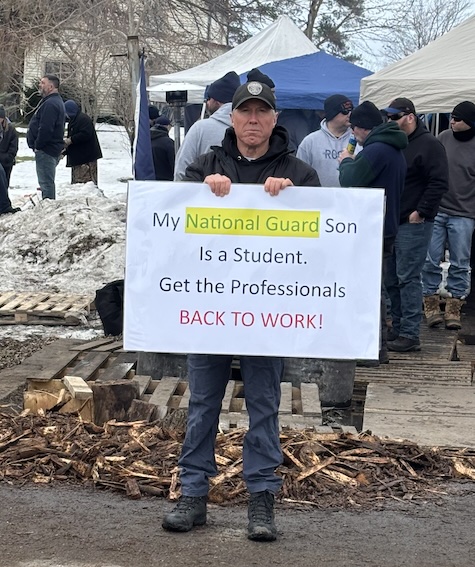
Photo courtesy of Scott Joerger: Scott Joerger of Rochester, whose son is in the National Guard, holds a sign on Wednesday with striking corrections officers in Albion at Gaines Basin Road, across from the Orleans Correctional Facility. Joerger’s son is currently assisting in one of the prisons in Albion. “Get the professionals BACK TO WORK!” the sign states. About 6,500 National Guard members have been activated to work in the prisons during the strike. Joerger said he supports the COs and hopes their concerns are addressed by the state.
The union representing corrections officers said it expects the state will make a formal offer today to striking COs who have refused to go to work in the prisons for about 10 days.
Day three of mediation between the union and the state concluded at midnight last night, said James Miller, spokesman for the union, New York State Correctional Officers & Police Benevolent Association.
“The leadership of NYSCOPBA is meeting with the State late this morning,” Miller said in a message to the media. “It is expected that the State will have a formal offer to the demands of those who have refused to work during the labor dispute. I don’t have any information on any concessions or what demands will be met.”
Many corrections officers went on strike Feb. 17 at Collins and Elmira prisons, and those strikes spread to the majority of the 42 prisons in the state by the next day, including the two prisons in Albion.
As public employees, the correction officers can’t legally go on strike, according to the Taylor Law. A judge also told the COs to return to work. The union hasn’t sanctioned the strike.
Correction officers say the prisons have been understaffed leading to mandatory overtime that often is 60 to 80 hours a week for officers. They say they are spending too much time away from their families.
Officers also want an end to the HALT Act, which has changed the way solitary confinement is used as punishment. The union says the HALT Act has made the prisons less safe, resulting in more attacks from inmates on other inmates and staff in the correctional facilities.
Return to top
Photo by Tom Rivers: This miniature clay model of a reindeer was created by Brian Porter of Pendleton in Niagara County. He would like to make the reindeer as a bronze statue to tie in with Albion’s Christmas heritage as a home to a school for Santas.
ALBION – The Village Board on Wednesday gave its support to a sculpture of a reindeer, but the board wants the project to be funded with donations and grants – not taxpayer dollars.
The board held a public hearing on Wednesday about whether to commit village funds towards a life-size model of a reindeer. It would cost $12,500 to have Brian Porter make a clay model of the reindeer.
Village Trustee Joyce Riley is leading the effort for the new sculpture, which she sees as a community-building project and a way to further promote Albion’s heritage as the home of a school for Santas and also the Christmas Park attraction led by the late Charles Howard in the 1950s and 1960s. Howard established the Santa School in 1937 and ran it until his death in 1966. The school continues in his name in Midland, Mich.
The clay model of reindeer is needed before it can be cast in bronze. The bronze statue would cost an estimated $65,000. Duplicates of the reindeer could be made with a less costly metal. Porter is the sculptor who made the bronze statue of Santa in Albion and also the soldier in Medina by the YMCA, which was originally the Medina Armory.
Riley would like to see many of the reindeer around the community. She thinks the reindeer will add to other recent efforts with the statue of Santa in honor of Charles Howard, and Christmas-themed signs and murals. The Albion Betterment Committee also is working to have a Santa House on Main Street next to the Presbyterian church and a municipal parking lot.
Deputy Mayor Greg Bennett said continuing to build on a year-round Christmas theme makes sense for Albion. But he doesn’t want taxpayer funds committed to the project, especially when village taxes have been on the rise. The 2024-25 village budget increased taxes by 6.6 percent with the tax rate passing $20 per $1,000 of assessed property for the first time.
“I’m all for this,” Bennett said about the reindeer sculptures. “It’s branding the community and taking Christmas to another step. I love the idea but we’ve raised taxes so much on people.”
The board voted to create an account where people can donate towards the project. Albion received the first $200 towards the project during the meeting when code enforcement officer Chris Kinter and sewer plant chief operator Aric Albright each gave $100.
“You want a destination location for people to come to,” Kinter said.
Riley said she would donate, too. Her brother Xavier Riley, now a Texas resident, attended the meeting and said he would contribute as well. He thinks the reindeer and Christmas focus present an opportunity for businesses to sell merchandise and entice visitors.
Debbie Thies, a Albion resident, spoke during the hearing and said she supports the reindeer sculpture.
“I love the reindeer idea,” she said. “I think Albion needs to take advantage of Christmas.”
Riley said she is confident the $12,500 can be raised from donations. She would like those funds to be raised by the end of April so Porter can then be hired to make the clay model in time for an Erie Canal festival in late September.
Trustee William Gabalski also said there are other lower-cost options for a bronze reindeer. He showed her one bronze option for about $10,000. Riley said she would look at that option, too.
Gabalski said he thinks the reindeer make sense for Albion, but he doesn’t want taxpayer money to go towards it – “given all we are up against.” The board is facing budget challenges from many fronts, he said.
Return to topAgency seeks to expand the effort to other districts in Genesee and Orleans

Provided photos: The Genesee Orleans Ministry of Concern has started a food and personal care pantry at Albion Central School in the middle and high schools. Those pictured include from left Rose Friedl, youth coordinator for GOMOC; Jami Allport, executive director for GOMOC; and Brittany Barleben, middle and high school social worker.
Press Release, Genesee Orleans Ministry of Concern
ALBION – In response to the growing need for accessible resources to support students’ well-being, Genesee Orleans Ministry of Concern has partnered with United Way of Orleans and excited to announce the launch of a pilot food and personal care item pantry program in Albion Central School District.
This initiative aims to provide students with essential resources, helping to reduce barriers to learning and promote a healthier, more equitable educational environment.
The pantry will offer students free access to food and personal care items, including nutritious snacks, hygiene products, and toiletries. The goal is to ensure that no student faces hunger or discomfort due to a lack of basic resources, enabling them to focus on their education and thrive academically. By establishing these pantries directly within schools, Genesee Orleans Ministry of Concern hopes to create a supportive, stigma-free space where students can discreetly take what they need.
“Every student deserves the opportunity to succeed, and access to basic necessities should never be a barrier to learning,” said Jami Allport, the executive director of GOMOC. “Through this pilot program, we aim to provide crucial support to students who might otherwise go without, helping to foster a more inclusive, supportive school environment.”
The program will be rolled out in public schools in Genesee and Orleans counties through a grant with Fidelis Care.
“Once we receive the grant funds, we will be contacting public schools in Genesee and Orleans County to discuss their needs and how we can support them,” she said.
School staff will work closely with students and families to ensure the pantry is stocked with the most requested items. The program also aims to involve the community through donations and volunteer opportunities, fostering a sense of shared responsibility and solidarity.
“The pantry is an essential step in meeting the needs of our students beyond the classroom,” Allport said. “By providing food and personal care items, we are not only addressing physical needs but also reinforcing the importance of well-being as a foundation for academic success.”
For more information about the food and personal care item pantry program or to get involved, please contact the Ministry of Concern at 585-589-9210.
Union expresses disappointment with delays, downsized addition to fire station
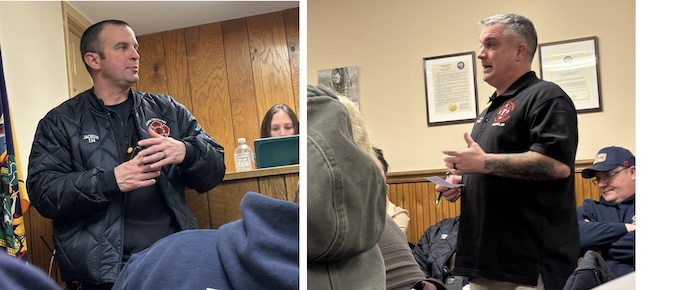
Photos by Tom Rivers: (Left) Medina Fire Chief Matt Jackson speaks during Monday’s Village Board meeting, sharing his concerns about aging fire trucks. (Right) Stephen Miller, president of Medina Professional Firefighters IAFF Local 2161, said the union “has lost faith in the village leadership.”
MEDINA – The Village Board heard impassioned pleas from residents and the firefighters’ union on Monday, with residents worried that taxes are too high and pushing people out of their homes.
The union said the fire department has at least two fire trucks that should be replaced and soon be put out of service. The firefighters’ union president, Stephen Miller, also said the recent move to drastically downscale an upgrade and addition to the fire hall is inadequate and doesn’t meet the operational needs of the department.
“The membership has lost faith in the village leadership,” Miller said during a meeting Monday in a packed meeting room at the Ridgeway Town Hall. Many firefighters stood in the hallway because there wasn’t enough chairs and space in the main room.
He urged the board to take immediate action on upgrading the fire hall and the apparatus.
Miller said delays in moving forward with needed upgrades have resulted in much higher costs.
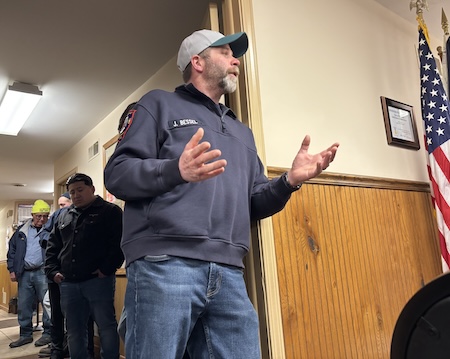
Jason Bessel, a Ridgeway firefighter, said the costs of new fire trucks have dramatically risen in recent years. Ridgeway just received a new fire engine for $860,000. Bessel said it was a five-year process to get the truck.
Medina’s ladder truck is 29 years old. One of the fire engines is 31 years old. The fire department pushed years ago to start the process of getting a new ladder truck. Miller said the cost in 2021 was projected at $1.3 million. When the board voted on getting a new one in June 2023, the cost jumped to $1.7 million.
The fire department also has been urging the board to fix a series of problems in the current fire hall, and also put on an addition needed for a new ladder truck. The new ladder trucks are bigger than the one from 1996, which already barely fits in the fire hall.
The board was expecting $4.5 million to fix the current fire hall and put on a two-bay addition. But the projections came in over $6 million, prompting the board to scale down the project to a one-bay addition only without addressing the shortcomings in the current fire hall. That one-bay addition is projected at $1,041,590.
But even the $1 million cost will be hard on village taxpayers, said Trustee Debbie Padoleski. Paying for that addition, plus the new ladder truck, will overwhelm many taxpayers who Padoleski already said are stressed in their village taxes.
“I know in talking with taxpayers in this village they are ready to look at a new way of doing business,” Padoleski said.
She is open to looking at a fire district which would move the fire department out of the village budget and into its own taxing jurisdiction. Medina FD could perhaps join with nearby volunteer fire companies in a larger joint district.
Padoleski said Medina’s Fire Department, the only one with paid staff in the county, provides extensive mutual aid to other towns, including with the ladder truck, yet the village is left to foot the bill for the fire department.
“The village pays too much for fire service compared to the towns,” Padoleski said. “We need a financially equitable solution from the county.”
Trustee Jess Marciano said the village needs to keep the pressure on the County Legislature to significantly increase how it shares the local sales tax. The county hasn’t increased the amount to the local towns and villages since 2001, despite the sales tax revenues more than doubling in that time.
The village will get $159,630 of the sales tax in 2025 out of a total expected to be around $23 million this year. That is less than 1 percent for Medina of the total local sales tax in the county.
“This is not sustainable,” Marciano said about the continued freeze in funding. “We are all neighbors. They ought to be listening to us.”
The county needs to increase the amount of sales tax for the towns and villages to help them keep up with the costs of equipment and personnel.
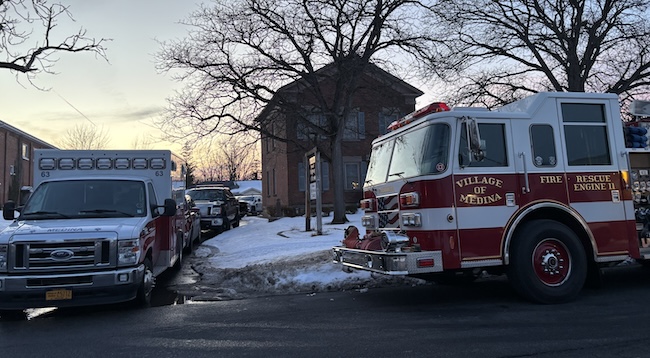
The Medina Fire Department brought a fire engine and ambulance to the board meeting on Monday, which was held at the Ridgeway Town hall. The Medina Historical Society is next to the town hall. Firefighters are urging the Village Board to find a way to update equipment and the facilities for the fire department.
Linda Limina, a village resident and member of the Shelby Town Board, says the taxpayers are struggling and some can’t even pay their water bills. Medina needs to find a better way to upgrade needed equipment without overburdening the village taxpayers, Limina said.
Mayor Marguerite Sherman said the Village Board has an obligation to firefighters and the police officers to provide them with safe and reliable equipment, especially when they are risking their lives in dangerous professions. That is not only police cars and fire trucks, but air packs and bullet-proof vests, Sherman said.
“I don’t want to raise taxes,” Sherman said. “But we need a fire truck and ambulance to show up in an emergency.”
The ladder truck is expected to arrive around Christmas in about 10 months. Marciano said the village can figure out where to keep it in the short term until an addition is ready, likely in early 2026.
Sherman said she will present the financial numbers on the projected annual debt service payments for the ladder truck and the addition during the next board meeting, March 10.
She said she is also pursuing grants for the truck and addition, but there won’t be a commitment on that for many months, if at all.
Sherman said the village faces other needs, from upgrading water and sewer lines, police cars and improvements to Boxwood Cemetery.
“There is a lot,” she said about the issues facing the village.
The board will soon be focusing on the village budget for 2025-26. That spending plan needs to be adopted by April 30.
Return to top





















